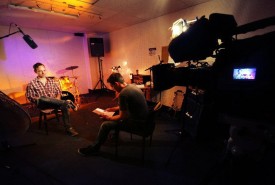
I recently attended a talk by filmmaker and motion graphics designer Ben Lewis about the making of his music documentary Who Do You Love: The King Adora Story. With candid interviews and access to the band’s own camcorder footage, Who Do You Love tells the story of not just King Adora but a whole industry in transition. Ben kindly agreed to answer some questions about the making of the film, how it was financed and how it was distributed.
Why did you feel that the story of King Adora was one that needed to be told?
In all honesty my initial reasoning behind the project was to document a chapter in my friend’s life. I had been working at Apple as a creative trainer and I wanted to get back into making films; as opposed to teaching others to do so. I’ve known Martyn, the lead guitarist from the band, since secondary school and I was aware he had this experience so I really wanted to delve deeper. It was initially simply a gift to him to document that time in his life. Once I had begun producing the film I came to the realisation that I could produce a piece of work that not only appealed to King Adora fans but a wider audience.
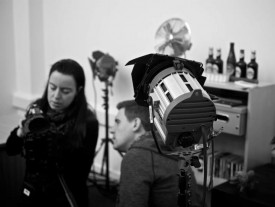
What advantages did knowing band members personally give you? Were there any disadvantages?
I knew all the band but Martyn was a close friend. All of the band were at a different stage in their lives and I explained to them from the outset although I had an attachment to the them, I would not let that affect me in the filmmaking process. I wanted to tell a truthful story of their journey. I did feel protective of the band but I just had to put that aside and remember that original credo. So in a sense it was a double-edged sword in that they knew me so that allowed for a more relaxed interview environment but they also knew I wasn’t going to pull any punches. I had a free reign to ask what I wanted and use that in the story I wanted to tell.
How was the film financed?
It was self-funded. During my last few months at Apple I was spending my wages on hiring the Red One and lenses. It’s certainly not the best way to get a project made but I felt I didn’t want to wait and seeing as it was such a personal project I felt why shouldn’t I pay to get it made? I was using the currency of friends too; so, I calculated that it would cost about £6K in total for kit hire and travel etc. However, had I been paying them a day rate it would have been a lot more.
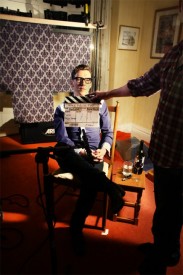
What are the biggest things you learnt along the way about crowd-funding?
I was totally new to crowd-funding. I loved the idea of it and it fit in with the other aspects of the democratisation of the creative industries that excited me. I love the idea you can circumvent the traditional funding platforms and have a direct link to your audience. The film was in the can and ready to go so I was purely looking for distribution costs for the DVD. That clearly helped as prospective backers knew the product was ready. That said, like the entire project, I was working on the promotion of the crowd-funding whilst working full time. I learnt that to raise the funding target is a full time job in itself. I had help from a friend but I feel that the most successful campaigns require constant updates and communication with your potential backers. I raised enough for the distribution of the DVD but not my full target amount.
How long did it take to shoot and how many crew were you working with?
It made over the course of a couple of years as we were all making it around our day jobs. In terms of days it’s hard to calculate. It took us a while to get in touch with certain members of the band. Robbie (bass player) was living in New York and we had to wait for him to get back to the UK for the interview; though I had considered going over to interview him. There was also a lot of archive footage that needed logging and various other production logistics such as clearance and filming the live gigs.
The crew was very small: myself, Laura the DOP and Ash who edited the project. On certain interviews we called in help from others too but really it was the three of us who got the project made.
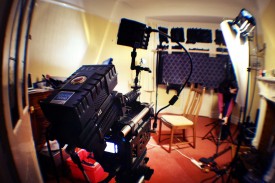
What cameras did you use and did you encounter any technical problems?
I knew from the outset that I wanted the interviews to have a very intimate look with a shallow depth of field and to look nicely lit to contrast the grainy archive footage. I’d recently been on a Red One training course with my DOP, Laura. I thought that the image these cameras gave would be ideal for the look and feel I was trying to achieve. We shot the first three interviews with the Red but it became too cost prohibitive and we moved to the Canon 5D MKII. Laura did a great job lighting the interview but unfortunately she wasn’t available to shoot Dan’s interview so I shot that interview after getting advice from her.
Once we got to the edit stage we had mastered all the Red content to 1920×1080 Prores files as I wasn’t sure my machine could handle the R3Ds. When it came to the grade we relinked to the original Red files. Shooting with the 5D was great but the Prores conversions took some time. I’ve recently moved to Premiere CS6 and love how you can use H.264 natively. This saves a lot of time… and space!
What problems did you have with licensing the music?
Well this was a whole new world to me. I had lots of issues with the clearance of the music. I initially had to clear a couple of tracks and clips from one of the band’s videos for use in the first trailer I released. I had contacted Universal for international sync rights for online distribution which would allow me to use the songs and footage for six months but the initial cost was too steep. I managed to negotiate a lower rate as I was an independent but when it came to the rights for the entire film I just couldn’t afford the figure the record company were asking so I had to look into other options.
The music was intrinsic to the story and I had to think of another way to use the tracks. I contacted Dan (drummer) and asked if he had access to live tracks that had been recorded that didn’t have copyright. It turned out that he had lots of tracks available from various gigs over the years so we ended up using those. Having the audience noise actually added something. The extra ambiance gave it an additional energy which worked really well.
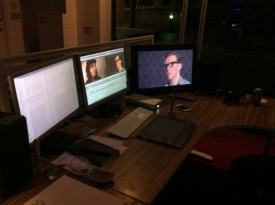
Do you feel Who Do You Love has helped your career, and what will your next project be?
Yeah, the film’s helped me many ways. It has given me a lot more confidence as a producer/director and it is a calling card that I’m incredibly proud of.
It’s a film that a lot of people have thought had a large crew and a budget that was far more than it actually cost to produce. It was really the three of us that made the film in our spare time, around our day jobs and on an ultra-low budget. After completing the film I honestly didn’t want to go near a long-form project again. I was looking to do a music promo and was in preproduction to do a video for a local band which unfortunately didn’t work out. I had been looking for examples of Brutalist architecture and was on a tour of Birmingham City Library when it dawned on me how many great stories that place holds. The gentleman who was escorting us around spoke with such passion about the place that I was re-energised to make another documentary. It’s still at an embryonic stage but the ball’s rolling and I’m looking forward to it.
Good luck with that, Ben. And finally, where can people buy or view the film?
The film is available to buy at www.kingadora.com. The DVD contains the feature, full interviews with Steve Lamacq and John Cornfield and a vox pops feature.
I’ll be doing a digital release at some point too either via Vimeo Pay per View or Distrify.